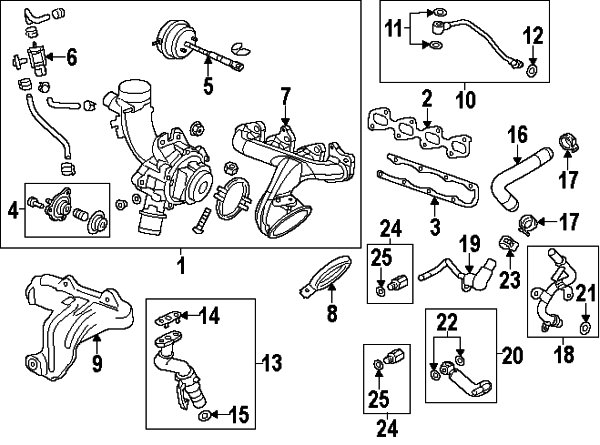How-To: Replace Turbo Oil Feed Line
Overview:
The turbo oil feed line has a tendency to leak at the engine block seal after about 50,000 miles or 3 years. The replacement feed line on 2011-2013 models includes two o-rings instead of one in addition to an integrated heat shield over the o-rings and a heat shield around the length of the line to prevent oil coking and reduce oil temperatures. If this line is leaking, you will be able to see oil pooled up underneath it on the block's casting ridges in this picture.
Tools Required:
- E10 socket (A set is available on Amazon.com)
- Ratchet
- T45 Torx bit (A set is available on Amazon.com)
- Lb-ft Torque wrench (Available on Amazon.com)
- In-lb torque wrench (Available on Amazon.com)
Part Required:
GM part number: 55592600 (Available on Amazon.com)
Procedure:
Remove the three E10 bolts holding the heat shield over the turbo
![Image]()
![Image]()
Remove the E10 bolt holding the feed line onto the engine block
![Image]()
Loosen the T45 banjo/hollow bolt holding the feed line to the turbo, but do not remove entirely
![Image]()
Pull feed line from engine block. This took quite a bit of wiggling for me, but eventually popped out. Once you get it out, remove the turbo bolt. You should find two copper washers; one above and one below the feed line. The one below the feed line may be stuck to the turbo. If it is, a gentle tap to its outer edge with a flat-head screwdriver will loosen it. Be sure not to scratch the mating surface.
Clean the mating surface on the turbo of any debris, taking care not to scrape dust into the turbo.
Install new feed line. Be careful not to lose the two copper washers.
Torque T45 banjo bolt on the turbo to 30 Nm (22 lb ft). Torque the E10 bolt on the engine block to 10 Nm (89 lb in), or about "hand snug." Do not over-tighten this last bolt or you will have a really bad day. I recommend actually using an in-lb torque wrench for this.
![Image]()
Start the car and check for leaks.
Reinstall heat shield and torque E10 bolts also to "hand snug."
Old vs New photos:
![Image]()
![Image]()
Overview:
The turbo oil feed line has a tendency to leak at the engine block seal after about 50,000 miles or 3 years. The replacement feed line on 2011-2013 models includes two o-rings instead of one in addition to an integrated heat shield over the o-rings and a heat shield around the length of the line to prevent oil coking and reduce oil temperatures. If this line is leaking, you will be able to see oil pooled up underneath it on the block's casting ridges in this picture.
Tools Required:
- E10 socket (A set is available on Amazon.com)
- Ratchet
- T45 Torx bit (A set is available on Amazon.com)
- Lb-ft Torque wrench (Available on Amazon.com)
- In-lb torque wrench (Available on Amazon.com)
Part Required:
GM part number: 55592600 (Available on Amazon.com)
Procedure:
Remove the three E10 bolts holding the heat shield over the turbo
Remove the E10 bolt holding the feed line onto the engine block
Loosen the T45 banjo/hollow bolt holding the feed line to the turbo, but do not remove entirely
Pull feed line from engine block. This took quite a bit of wiggling for me, but eventually popped out. Once you get it out, remove the turbo bolt. You should find two copper washers; one above and one below the feed line. The one below the feed line may be stuck to the turbo. If it is, a gentle tap to its outer edge with a flat-head screwdriver will loosen it. Be sure not to scratch the mating surface.
Clean the mating surface on the turbo of any debris, taking care not to scrape dust into the turbo.
Install new feed line. Be careful not to lose the two copper washers.
Torque T45 banjo bolt on the turbo to 30 Nm (22 lb ft). Torque the E10 bolt on the engine block to 10 Nm (89 lb in), or about "hand snug." Do not over-tighten this last bolt or you will have a really bad day. I recommend actually using an in-lb torque wrench for this.
Start the car and check for leaks.
Reinstall heat shield and torque E10 bolts also to "hand snug."
Old vs New photos:















